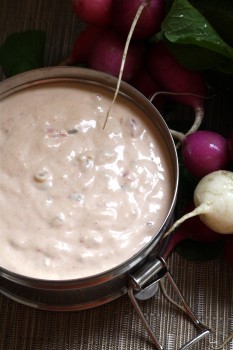 "Would you like Bleu cheese, French, Russian, Ranch, oil and vinegar, or Thousand Island dressing?" It was a familiar chant I'd hear from waiters and waitresses in restaurants high and low-end-- wherever I'd go in the 1970's.
"Would you like Bleu cheese, French, Russian, Ranch, oil and vinegar, or Thousand Island dressing?" It was a familiar chant I'd hear from waiters and waitresses in restaurants high and low-end-- wherever I'd go in the 1970's.
Some might lament this time in our history as a sort of Dark Age of salads-- iceberg lettuce, either crispy or wilted, anemic tomatoes, and a packet or two of saltines that never seemed to make it to their intended consumer fully intact-- the thin, clear packaging holding fast to either your fingers or the side of your soda glass thanks to static electricity.
Others might have viewed this time in our country's life as a sort of Golden Age for thick, creamy salad dressings-- some much needed zing and oomph to perk up (or completely drown) the most flaccid of leafy green offerings.
I was strictly an oil and vinegar fellow. I shied away from the heavy stuff because I thought it would make me phlegmy. The Blue cheese dressing my mother preferred made me gag, the French looked like an aged whore with a terrible dye job, and the Russian seemed positively treasonous back then. The Ranch dressing, however, was appealing since it made me think of cowboys in tight jeans who smoked and drank and slept together in bunk houses when they weren't busy soaping each other up in antique horse troughs. I approached that dressing carefully. I would order a little bit of it on the side. It was for my french fries in case anybody asked.
And what about Thousand Island dressing? It left me completely baffled. I tried to imagine palm trees and tropical fruit and people wearing very little in the way of clothing, but things just didn't seem right. The people were always naturally a few shades darker than myself, as if they'd been sunning themselves on some kind of never-ending summer vacation. They were happy and beautiful and exotic. But then they came up with this mayo-based, pickle-and- chili-sauce-infused dressing to represent themselves? It made no sense.